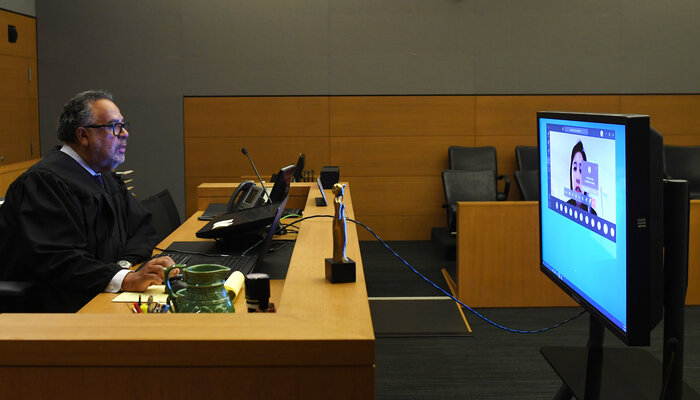Introduction
The Brennan Center has also developed a set of principles stakeholders can use as they develop policies for the use of remote court proceedings, available here.
The Covid-19 pandemic has disrupted court operations across the country, prompting judges to postpone nonessential proceedings and conduct others through video or phone.footnote1_m9vTq-apc7b0KOFHC0CIWDeJGRSau8TvLv7PDG8x7M_xgEEOkGqe0Aq1 Brennan Center for Justice, Courts’ Responses to the Covid-19 Crisis, last updated September 10, 2020, https://www.brennancenter.org/our-work/research-reports/courts-responses-covid-19-crisis. Even as courts have begun to reopen, many are also continuing or testing new ways to expand the use of remote technology.footnote2_5AKY1HwiwuYeC1EjGGUYe4djenWYiKRBjkSUBvt0uI_kSZlljcIuJtI2 Daniel Siegel, “Miami, Orlando Headline Fla. Courts’ Remote Trial Experiment,” Law360, June 4, 2020, https://www.law360.com/articles/1279653/miami-orlando-headline-fla-courts-remote-trial-experiment.; and Jake Bleiberg, “Texas Court Holds First US Jury Trial via Videoconferencing,” Associated Press, May 22, 2020, https://abcnews.go.com/Health/wireStory/texas-court-holds-us-jury-trial-videoconferencing-70825080. At the same time, public health concerns are leading some legal services providers and other advocates to oppose the return to in-person proceedings.footnote3_ExlfSu2vSicGI6ZB82fiwcwrwEf3nWrekDJ-I7dA1vU_xt0zNQZYPw5s3 Rocco Parascandola and Molly Crane-Newman, “Lawyers Fear Sudden Return to NYC Courthouses Next Week will Spread Coronavirus,” Daily News, July 8, 2020, https://www.nydailynews.com/new-york/nyc-crime/ny-courts-reopening-early-outrage-lawyers-advocates-20200708–42rpmgyhyjc2jphrqohwdsyy6q-story.html. Beyond the current moment, several court leaders have also suggested that expanded use of remote technology should become a permanent feature of our justice system.footnote4_qcoCSVAqopIBDGS0RUEG8GmiptD2DoGDtIGxkDyKlWg_eHeEfU6zvJAK4 Lyle Moran, “How Hosting a National Pandemic Summit Aided the Nebraska Courts System with its Covid-10 Response,” Legal Rebels Podcast, May 13, 2020, https://www.abajournal.com/legalrebels/article/rebels_podcast_episode_052.; and Katelyn Kivel, “How the Coronavirus Revolutionized Michigan’s Courts,” The Gander Newsroom, July 14, 2020, https://gandernewsroom.com/2020/07/14/coronavirus-revolutionized-courts/.
Remote technology has been a vital tool for courts in the midst of a public health crisis. But the use of remote technology — and its possible expansion — also raises critical questions about how litigants’ rights and their access to justice may be impacted, either positively or negatively, and what courts and other stakeholders can do to mitigate any harms.
This paper collects and summarizes existing scholarship on the effects of video technology in court proceedings. Federal courts, immigration courts, and state courts have long used video technology for certain kinds of proceedings.footnote5_pDSdRWyAfAYMLRPCjgCCMuYpHTKjZuRJHzllXY1bpE_zqIOlgtAdlYx5 Shari Seidman Diamond et al., “Efficiency and Cost: The Impact of Videoconferenced Hearings on Bail Decisions,” Journal of Criminal Law and Criminology 100 (2010): 877–878, 900; Ingrid V. Eagly, “Remote Adjudication in Immigration,” Northwestern University Law Review 109 (2015): 934; and Mike L. Bridenback, Study of State Trial Courts Use of Remote Technology, National Association for Presiding Judges and Court Executive Officers, 2016, 12, http://napco4courtleaders.org/wp-content/uploads/2016/08/Emerging-Court-Technologies-9–27-Bridenback.pdf. While the available scholarship on the use of video proceedings is limited, existing research suggests reason for caution in expanding the use of these practices, as well as the need for further research on their potential effects.
For Example:
- One study of criminal bail hearings found that defendants whose hearings were conducted over video had substantially higher bond amounts set than their in-person counterparts, with increases ranging from 54 to 90 percent, depending on the offense.footnote6_Lm64g98vYHgUksvTjs4G75MlKyYAfoAX4SElMBWIsvQ_pL1XkCtZ9bHz6 Diamond et al., “Efficiency and Cost,” 893.
- A study of immigration courts found that detained individuals were more likely to be deported when their hearings occurred over video conference rather than in person.footnote7_9Xr156JI6XH-djDzvpV4ERv9PPPOxDe77oox6t6hlZo_lb17f0lMEotu7 Eagly, “Remote Adjudication,” 966; and Frank M. Walsh and Edward M. Walsh, “Effective Processing or Assembly-Line Justice – The Use of Videoconferenceing in Asylum Removal Hearings,” Georgetown Immigration Law Journal 22 (2008): 271–72.
- Several studies of remote witness testimony by children found that the children were perceived as less accurate, believable, consistent, and confident when appearing over video.footnote8_vxw-BxaeP8CvVSByiaw-m1fnWyeWd2tRdgB40y5RBFo_xCnnywCd8YPc8 Holly K. Orcutt et al., “Detecting Deception in Children’s Testimony: Factfinders’ Abilities to Reach the Truth in Open Court and Closed-Circuit Trials,” Law and Human Behavior 25 (2001): 357–8, 366. However, it is important to note that these studies are simulated experiments and not observations of actual court proceedings, so outcomes might have differed if video proceedings were used and examined in an actual court hearing. Also worth noting is that the judge, bailiff, and attorneys questioning the children were in the room with the children testifying; the children only appeared by CCTV to the mock jurors.
- In three out of six surveyed immigration courts, judges identified instances where they had changed credibility assessments made during a video hearing after holding an in-person hearing.footnote9_OzSDrjTmOK8NhHfwlowgsGCh1EW-bLInI1o-YyNo60_yRamfULWiiSx9 Government Accountability Office, Actions Needed to Reduce Case Backlog and Address Long-Standing Management and Operational Challenges, 2017, 55, https://www.gao.gov/assets/690/685022.pdf.
Research also suggests that the use of remote video proceedings can make attorney-client communications more difficult. For example, a 2010 survey by the National Center for State Courts found that 37 percent of courts using videoconferencing had no provisions to enable private communications between attorneys and their clients when they were in separate locations.footnote10_QI-MH183o1fM5eIEUa57hsVxzSqclb38bIVm9VJYyo_c5eXBwTftz8n10 Eric Bellone, “Private Attorney- Client Communications and the Effect of Videoconferencing in the Courtroom,” Journal of International Commercial Law and Technology 8 (2013): 44–45. Remote proceedings can likewise make it harder for self-represented litigants to obtain representation and other forms of support by separating them from the physical courthouse. A study of immigration hearings found that detained immigrants who appeared in person were 35 percent more likely to obtain counsel than those who appeared remotely.footnote11_IBMeBFciK3YkgbE4bZKZwdDUdn6LaV8v2DlkpwpGzjI_uzVQPqO9ztV511 Eagly, “Remote Adjudication,” 938.
At the same time, other research suggests that remote video proceedings may also enhance access to justice under some circumstances. For example, a Montana study found that the use of video hearings allowed legal aid organizations to reach previously underserved parts of the state.footnote12_8blucwQQPP0ybD-0QSbG-LH3nlogOidmHZFcvc4ncOE_wFktC8QpyIQk12 Richard Zorza, Video Conferencing for Access to Justice: An Evaluation of the Montana Experiment, Legal Services Corporation, 2007, 1, 3, https://docplayer.net/3126017-Video-conferencing-for-access-to-justice-an-evaluation-of-the-montana-experiment-final-report.html. Organizations such as the Conference of Chief Justices have called for the expanded use of video or telephone proceedings in civil cases, particularly for self-represented and low-income litigants, as a way of reducing costs for those who, for example, may need to take time off work to travel to court.footnote13_065jhQlmRI7r9PTgZz5zTJQJq18JSGx28CUnoP-n94_rcFvz8TVGtdf13 National Center for State Courts, Call to Action: Achieving Civil Justice for All, 2016, 37–38 https://iaals.du.edu/publications/call-action-achieving-civil-justice-all.
One challenge in interpreting this research is that court systems hear a wide range of cases, both civil and criminal, and the use of videoconferencing may pose widely disparate challenges and benefits for litigants in different types of cases. Courts are involved in adjudicating everything from evictions to traffic violations, from multimillion-dollar commercial disputes to felony cases. In some instances, litigants are detained in jails or detention centers. In others, they may be self-represented. Courts hold preliminary hearings, arraignments, settlement negotiations, scheduling conferences, arguments on legal motions, jury trials, and much more.
At its core, this review of existing scholarship underscores the need for broad stakeholder engagement in developing court policies involving remote proceedings, as well as the need for more research and evaluation as courts experiment with different systems.
End Notes
-
footnote1_m9vTq-apc7b0KOFHC0CIWDeJGRSau8TvLv7PDG8x7M_xgEEOkGqe0Aq
1
Brennan Center for Justice, Courts’ Responses to the Covid-19 Crisis, last updated September 10, 2020, https://www.brennancenter.org/our-work/research-reports/courts-responses-covid-19-crisis. -
footnote2_5AKY1HwiwuYeC1EjGGUYe4djenWYiKRBjkSUBvt0uI_kSZlljcIuJtI
2
Daniel Siegel, “Miami, Orlando Headline Fla. Courts’ Remote Trial Experiment,” Law360, June 4, 2020, https://www.law360.com/articles/1279653/miami-orlando-headline-fla-courts-remote-trial-experiment.; and Jake Bleiberg, “Texas Court Holds First US Jury Trial via Videoconferencing,” Associated Press, May 22, 2020, https://abcnews.go.com/Health/wireStory/texas-court-holds-us-jury-trial-videoconferencing-70825080. -
footnote3_ExlfSu2vSicGI6ZB82fiwcwrwEf3nWrekDJ-I7dA1vU_xt0zNQZYPw5s
3
Rocco Parascandola and Molly Crane-Newman, “Lawyers Fear Sudden Return to NYC Courthouses Next Week will Spread Coronavirus,” Daily News, July 8, 2020, https://www.nydailynews.com/new-york/nyc-crime/ny-courts-reopening-early-outrage-lawyers-advocates-20200708–42rpmgyhyjc2jphrqohwdsyy6q-story.html. -
footnote4_qcoCSVAqopIBDGS0RUEG8GmiptD2DoGDtIGxkDyKlWg_eHeEfU6zvJAK
4
Lyle Moran, “How Hosting a National Pandemic Summit Aided the Nebraska Courts System with its Covid-10 Response,” Legal Rebels Podcast, May 13, 2020, https://www.abajournal.com/legalrebels/article/rebels_podcast_episode_052.; and Katelyn Kivel, “How the Coronavirus Revolutionized Michigan’s Courts,” The Gander Newsroom, July 14, 2020, https://gandernewsroom.com/2020/07/14/coronavirus-revolutionized-courts/. -
footnote5_pDSdRWyAfAYMLRPCjgCCMuYpHTKjZuRJHzllXY1bpE_zqIOlgtAdlYx
5
Shari Seidman Diamond et al., “Efficiency and Cost: The Impact of Videoconferenced Hearings on Bail Decisions,” Journal of Criminal Law and Criminology 100 (2010): 877–878, 900; Ingrid V. Eagly, “Remote Adjudication in Immigration,” Northwestern University Law Review 109 (2015): 934; and Mike L. Bridenback, Study of State Trial Courts Use of Remote Technology, National Association for Presiding Judges and Court Executive Officers, 2016, 12, http://napco4courtleaders.org/wp-content/uploads/2016/08/Emerging-Court-Technologies-9–27-Bridenback.pdf. -
footnote6_Lm64g98vYHgUksvTjs4G75MlKyYAfoAX4SElMBWIsvQ_pL1XkCtZ9bHz
6
Diamond et al., “Efficiency and Cost,” 893. -
footnote7_9Xr156JI6XH-djDzvpV4ERv9PPPOxDe77oox6t6hlZo_lb17f0lMEotu
7
Eagly, “Remote Adjudication,” 966; and Frank M. Walsh and Edward M. Walsh, “Effective Processing or Assembly-Line Justice – The Use of Videoconferenceing in Asylum Removal Hearings,” Georgetown Immigration Law Journal 22 (2008): 271–72. -
footnote8_vxw-BxaeP8CvVSByiaw-m1fnWyeWd2tRdgB40y5RBFo_xCnnywCd8YPc
8
Holly K. Orcutt et al., “Detecting Deception in Children’s Testimony: Factfinders’ Abilities to Reach the Truth in Open Court and Closed-Circuit Trials,” Law and Human Behavior 25 (2001): 357–8, 366. However, it is important to note that these studies are simulated experiments and not observations of actual court proceedings, so outcomes might have differed if video proceedings were used and examined in an actual court hearing. Also worth noting is that the judge, bailiff, and attorneys questioning the children were in the room with the children testifying; the children only appeared by CCTV to the mock jurors. -
footnote9_OzSDrjTmOK8NhHfwlowgsGCh1EW-bLInI1o-YyNo60_yRamfULWiiSx
9
Government Accountability Office, Actions Needed to Reduce Case Backlog and Address Long-Standing Management and Operational Challenges, 2017, 55, https://www.gao.gov/assets/690/685022.pdf. -
footnote10_QI-MH183o1fM5eIEUa57hsVxzSqclb38bIVm9VJYyo_c5eXBwTftz8n
10
Eric Bellone, “Private Attorney- Client Communications and the Effect of Videoconferencing in the Courtroom,” Journal of International Commercial Law and Technology 8 (2013): 44–45. -
footnote11_IBMeBFciK3YkgbE4bZKZwdDUdn6LaV8v2DlkpwpGzjI_uzVQPqO9ztV5
11
Eagly, “Remote Adjudication,” 938. -
footnote12_8blucwQQPP0ybD-0QSbG-LH3nlogOidmHZFcvc4ncOE_wFktC8QpyIQk
12
Richard Zorza, Video Conferencing for Access to Justice: An Evaluation of the Montana Experiment, Legal Services Corporation, 2007, 1, 3, https://docplayer.net/3126017-Video-conferencing-for-access-to-justice-an-evaluation-of-the-montana-experiment-final-report.html. -
footnote13_065jhQlmRI7r9PTgZz5zTJQJq18JSGx28CUnoP-n94_rcFvz8TVGtdf
13
National Center for State Courts, Call to Action: Achieving Civil Justice for All, 2016, 37–38 https://iaals.du.edu/publications/call-action-achieving-civil-justice-all.





